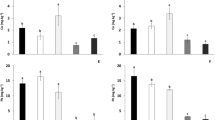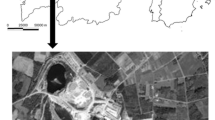Abstract
Biochar (BC) as soil amendment has the potential to support the remediation of polluted soils. The aim of our study was to test metal extractability in a contaminated soil and metal accumulation in plants in response to the application of BC and compost-based and inorganic soil amendments. The soil used in our study was taken from a long-term polluted site in Austria (Arnoldstein). The treatments included three BC/compost mixtures (50/50 w/w; using three different BC types), two inorganic amendments (gravel sludge (GS) with siderite-bearing (Fe) material (GSFe, 50/50 w/w) and lime (L)) and an unamended control; each treatment consisted of 1.5 % in 1.2 kg soil. Poplar biochar (P-BC), GSFe and L significantly decreased the NH4NO3-extractable fraction of Pb, Zn and Cd, but not of Cu. The highest immobilisation effect within the organic amendments was found after P-BC, reducing NH4NO3-extractable Zn by 63 %. In contrast to the NH4NO3 extractions, heavy metal concentrations in the aboveground plant material (shoots of Lolium multiflorum) did not generally decrease. Still, Cd, Ni and Zn concentrations in L. multiflorum grown on the amended soil were lower after the P-BC treatment. Cu and Pb showed slightly higher plant concentrations upon amendment addition, indicating that NH4NO3 extractions did not entirely reflect plant availability. Our data show that the type of BC and the addition of compost are crucial when using sorbent additives as a remediation strategy for metal-polluted soils and that the desired immobilisation effects cannot be achieved for all heavy metals. Depending on the type of metal, specific biochars and compost mixtures can either cause immobilisation or mobilisation.


Similar content being viewed by others
References
Acosta, J. A., Jansen, B., Kalbitz, K., Faz, A., & Martínez-Martínez, S. (2011). Salinity increases mobility of heavy metals in soils. Chemosphere, 85(8), 1318–1324.
Ahmad, M., Rajapaksha, A. U., Lim, J. E., Zhang, M., Bolan, N., Mohan, D., et al. (2014). Biochar as a sorbent for contaminant management in soil and water: a review. Chemosphere, 99, 19–33.
Austrian Standards L 1083. (2006). Chemical analyses of soils—determination of acidity (pH value). Vienna: Austrian Standards Institute.
Austrian Standards L 1085. (2013). Chemical analyses of soils—method for the extraction of elements with a mixture of nitric-acid and perchloric-acid. Vienna: Austrian Standards Institute.
Austrian Standards L 1086. (2014). Chemical analyses of soils—extraction of the effective exchangeable cations Ca++, K+, Mg++, Na+ and Al+++, Fe+++, Mn++ and H+ by bariumchloride solution and determination of the exchange capacity. Vienna: Austrian Standards Institute.
Austrian Standards L 1087. (2012). Chemical analysis of soils—determination of “plant-available” phosphorus and potassium by the calcium-acetate-lactate (CAL)-method. Vienna: Austrian Standards Institute.
Austrian Standards L 1091. (2012). Chemical analyses of soils—determination of mineral nitrogen by extraction with calcium chloride solution—Nmin method. Vienna: Austrian Standards Institute.
Austrian Standards L 1094-1. (1999). Chemical analyses of soils—extraction of trace elements with ammonium nitrate solution. Vienna: Austrian Standards Institute.
Austrian Standards L 1099. (2007). Chemical analyses of soils—determination of the specific electrical conductivity. Vienna: Austrian Standards Institute.
Austrian Standards S 2088-2. (2014). Contaminated sites—part 2: application-specific evaluation of soil pollution of old sites and old waste dumps. Vienna: Austrian Standards Institute.
Beesley, L., Moreno-Jiménez, E., & Gomez-Eyles, J. L. (2010). Effects of biochar and greenwaste compost amendments on mobility, bioavailability and toxicity of inorganic and organic contaminants in a multi-element polluted soil. Environmental Pollution, 158(6), 2282–2287.
Beesley, L., Moreno-Jiménez, E., Gomez-Eyles, J. L., Harris, E., Robinson, B., & Sizmur, T. (2011). A review of biochars’ potential role in the remediation, revegetation and restoration of contaminated soils. Environmental Pollution, 159(12), 3269–3282.
Brennan, A., Jiménez, E. M., Puschenreiter, M., Alburquerque, J. A., & Switzer, C. (2014). Effects of biochar amendment on root traits and contaminant availability of maize plants in a copper and arsenic impacted soil. Plant and Soil, 379(1–2), 351–360.
Brümmer, G. W., Gerth, J., & Herms, U. (1986). Heavy metal species, mobility and availability in soils. Zeitschrift für Pflanzenernährung und Bodenkunde, 149, 382–398.
EEA (2011). European Environmental Agency. Soil. http://www.eea.europa.eu/themes/soil/intro. Accessed 04 January 2015
Directive 2002/32/EC of the European Parliament and of the Council on undesirable substances in animal feed. Official Journal of the European Communities, L 140/10, 7 May 2002
Friesl, W., Friedl, J., Platzer, K., Horak, O., & Gerzabek, M. H. (2006). Remediation of contaminated agricultural soils near a former Pb/Zn smelter in Austria: batch, pot and field experiments. Environmental Pollution, 144(1), 40–50.
Friesl-Hanl, W., Platzer, K., Horak, O., & Gerzabek, M. H. (2009). Immobilising of Cd, Pb, and Zn contaminated arable soils close to a former Pb/Zn smelter: a field study in Austria over 5 years. Environmental Geochemistry and Health, 31, 581–594.
Granzin, S. & Valtl, M. (2014). Verdachtsflächenkataster und Altlastenatlas. Austrian Environmental Agency. http://www.umweltbundesamt.at/aktuell/publikationen/publikationssuche/publikationsdetail/?pub_id=2047. Accessed 29 March 2015.
Granzin, S. & Valtl, M. (2015). Verdachtsflächenkataster und Altlastenatlas. Austrian Environmental Agency. http://www.umweltbundesamt.at/aktuell/publikationen/publikationssuche/publikationsdetail/?pub_id=2096. Accessed 30 March 2015.
Hartley, W., & Lepp, N. W. (2008). Remediation of arsenic contaminated soils by iron-oxide application, evaluated in terms of plant productivity, arsenic and phytotoxic metal uptake. Science of the Total Environment, 390(1), 35–44.
Houben, D., Evrard, L., & Sonnet, P. (2013). Mobility, bioavailability and pH-dependent leaching of cadmium, zinc and lead in a contaminated soil amended with biochar. Chemosphere, 92(11), 1450–1457.
Ippolito, J. A., Laird, D. A., & Busscher, W. J. (2012). Environmental benefits of biochar. Journal of Environmental Quality, 41(4), 967.
IUSS Working Group WRB. (2006). World reference base for soil resources 2006. World Soil Resources Reports No. 103. Rome: FAO.
Jiang, J., Xu, R., Jiang, T., & Li, Z. (2012). Immobilization of Cu(II), Pb(II) and Cd(II) by the addition of rice straw derived biochar to a simulated polluted Ultisol. Journal of Hazardous Materials, 229–230, 145–150.
Karami, N., Clemente, R., Moreno-Jiménez, E., Lepp, N. W., & Beesley, L. (2011). Efficiency of green waste compost and biochar soil amendments for reducing lead and copper mobility and uptake to ryegrass. Journal of Hazardous Materials, 191(1–3), 41–48.
Karer, J., Wimmer, B., Zehetner, F., Kloss, S., & Soja, G. (2013). Biochar application to temperate soils: effects on nutrient uptake and crop yield under field conditions. Agricultural and Food Science, 22, 390–403.
Kloss, S., Zehetner, F., Oburger, E., Buecker, J., Kitzler, B., Wenzel, W. W., et al. (2014). Trace element concentrations in leachates and mustard plant tissue (Sinapis alba L.) after biochar application to temperate soils. Science of the Total Environment, 481, 498–508.
Krebs, R., Gupta, S. K., Furrer, G., & Schulin, R. (1999). Gravel sludge as an immobilizing agent in soils contaminated by heavy metals: a field study. Water, Air, and Soil Pollution, 115(1–4), 465–479. Accessed 17 April 2015.
Kumpiene, J., Lagerkvist, A., & Maurice, C. (2008). Stabilization of As, Cr, Cu, Pb and Zn in soil using amendments—a review. Waste Management, 28(1), 215–225.
Kumpiene, J., Bert, V., Dimitriou, I., Eriksson, J., Friesl-Hanl, W., Galazka, R., et al. (2014). Selecting chemical and ecotoxicological test batteries for risk assessment of trace element-contaminated soils (phyto)managed by gentle remediation options (GRO). Science of the Total Environment, 496, 510–522.
Mench, M., Vangronsveld, J., Bleeker, P., Ruttens, A., Geebelen, W., & Lepp, N. (2006). Phytostabilisation of metal-contaminated sites. In Phytoremediation of metal-contaminated soils (pp. 109–190). Springer. http://link.springer.com/content/pdf/10.1007/1-4020-4688-X_5.pdf. Accessed 30 March 2015
Murphy, J. & Riley, J.P. (1962). A modified single solution method for the determination of phosphate in natural waters. Analytica Chimica Acta 27, 31–36.
Park, J. H., Choppala, G. K., Bolan, N. S., Chung, J. W., & Chuasavathi, T. (2011). Biochar reduces the bioavailability and phytotoxicity of heavy metals. Plant and Soil, 348(1–2), 439–451.
Puschenreiter, M., Horak, O., Friesl, W., Hartl, W., et al. (2005). Low-cost agricultural measures to reduce heavy metal transfer into the food chain—a review. Plant, Soil and Environment, 51(1), 1–11.
Rees, F., Simonnot, M. O., & Morel, J. L. (2014). Short-term effects of biochar on soil heavy metal mobility are controlled by intra-particle diffusion and soil pH increase: heavy metal mobility in biochar-amended soils. European Journal of Soil Science, 65(1), 149–161.
Rees, F., Germain, C., Sterckeman, T., & Morel, J.-L. (2015). Plant growth and metal uptake by a non-hyperaccumulating species (Lolium perenne) and a Cd-Zn hyperaccumulator (Noccaea caerulescens) in contaminated soils amended with biochar. Plant and Soil. doi:10.1007/s11104-015-2384-x.
Sauerbeck, D. (1982). Welche Schwermetallgehalte in Pflanzen dürfen nicht überschritten werden, um Wachstumsbeeinträchtigungen zu vermeiden? Landwirtschaftliche Forschung, 39, 108–129.
Schüller, H. (1969). Die CAL-Methode, eine neue Methode zur Bestimmung des pflanzenverfügbaren Phosphors in Böden. (In German, with English Abstract) Zeitschrift für Pflanzenernährung und Bodenkunde, 123 (1), 48–63.
Tang, J., Zhu, W., Kookana, R., & Katayama, A. (2013). Characteristics of biochar and its application in remediation of contaminated soil. Journal of Bioscience and Bioengineering, 116(6), 653–659.
Touceda-González, M., Brader, G., Antonielli, L., Balakrishnan Ravindran, V., Waldner, G., Friesl-Hanl, W. & Sessitsch, A. (2015). Bioavailability of heavy metals, plant growth and microbiome characteristics due to the amendment of immobilizers and the plant growth-promoting strain Burkholderia phytofirmans PsJN. Submitted to Soil Biology and Biochemistry, in press.
Uchimiya, M., Wartelle, L. H., Klasson, K. T., Fortier, C. A., & Lima, I. M. (2011). Influence of pyrolysis temperature on biochar property and function as a heavy metal sorbent in soil. Journal of Agricultural and Food Chemistry, 59(6), 2501–2510.
Zeng, F., Ali, S., Zhang, H., Ouyang, Y., Qiu, B., Wu, F., & Zhang, G. (2011). The influence of pH and organic matter content in paddy soil on heavy metal availability and their uptake by rice plants. Environmental Pollution, 159(1), 84–91.
Zhang, X., Wang, H., He, L., Lu, K., Sarmah, A., Li, J., et al. (2013). Using biochar for remediation of soils contaminated with heavy metals and organic pollutants. Environmental Science and Pollution Research, 20(12), 8472–8483.
Acknowledgments
The authors gratefully acknowledge the financial support from the Austrian Research Promotion Agency (Bridge-Programme, FFG Project no. 836538).
Author information
Authors and Affiliations
Corresponding author
Rights and permissions
About this article
Cite this article
Karer, J., Wawra, A., Zehetner, F. et al. Effects of Biochars and Compost Mixtures and Inorganic Additives on Immobilisation of Heavy Metals in Contaminated Soils. Water Air Soil Pollut 226, 342 (2015). https://doi.org/10.1007/s11270-015-2584-2
Received:
Accepted:
Published:
DOI: https://doi.org/10.1007/s11270-015-2584-2




